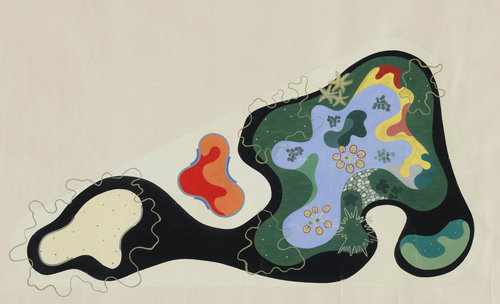In Situ
dal 7/4/2009 al 13/9/2009
Segnalato da
Frank Lloyd Wright
Philip Johnson
Edward Larrabee Barnes
Emilio Ambasz
Hans Hollein
Andres Lepik
Margot Weller
7/4/2009
In Situ
The Museum of Modern Art - MoMA, New York
Architecture and Landscape. The exhibition draws from the collection of Moma to examine the diverse attitudes towards landscape over the last 100 years. Featuring approximately 60 drawings, models, and videos, projects include single houses that frame the landscape, designs for buildings based on the surrounding landscape, urban gardens that compose nature within the city, and parks that transform former industrial areas into new attractions. The display closes with three cemeteries whose designs demonstrate that our relationship to landscape often transcends our quotidian needs.

The exhibition In Situ: Architecture and Landscape draws from
the rich collection of The Museum of Modern Art to examine the diverse attitudes towards
landscape over the last 100 years. Featuring approximately 60 drawings, models, and videos,
projects include single houses that frame the landscape, designs for buildings based on the
surrounding landscape, urban gardens that compose “nature” within the city, and parks that
transform former industrial areas into new attractions. The exhibition closes with three cemeteries
whose designs demonstrate that our relationship to landscape often transcends our quotidian
needs. The exhibition is on view in The Philip Johnson Architecture and Design Galleries, third
floor, from April 8 to September 14, 2009. It is organized by Andres Lepik, Curator, and Margot
Weller, Curatorial Assistant, Department of Architecture and Design, The Museum of Modern Art.
In recent decades landscape has taken on an expanded definition in architecture. In the
first half of the twentieth century, the architectural avant-garde celebrated autonomy from nature,
and architects devised utopian schemes for creating urban realms ex novo. More recently,
however, the challenges of a threatened environment and rapidly expanding cities have fostered a
revised understanding of landscape. Harmony between the spatial, social, and environmental
aspects of human life has become a priority in political thought, and this has had profound
reverberations in both architecture and landscape design. Landscape—no longer understood
merely as nature untouched—now encompasses complex interventions by architects and
landscape architects in urban and rural surroundings.
Frank Lloyd Wright’s famous Fallingwater, Edgar J Kaufmann House (1934-1937) in which
architecture becomes part of a dramatic setting in the nature, and Mies van der Rohe’s Wolf House
(1925-27), built atop a prominent ridge of Gubin overlooking the Neisse River Valley, are among
the earliest examples in the exhibition. The Wolf House served as an inspiration for Philip Johnson
and his design for the Glass House in New Canaan (1945-1947). Other examples that
demonstrate a similar profiting relationship between architecture and landscape are Edward
Larrabee Barnes’ Haystack Mountain School of Crafts (1958-61), Emilio Ambasz’s Casa de Retiro
Espiritual in Spain (1976-1979), and Diller + Scofidio’s Slow House project (1988-90). Hans
Hollein’s Vulcania (1994-2001), Tadao Ando’s Chikatsu-Asuka Historical Museum in Osaka (1989-
1994) or Toyo Ito’s Relaxation Park in Torrevieja, Spain (2001-2006) all seem to merge with their surroundings. Roberto Burle Marx’s lively landscape design for Saenz Pena Square (1948) and
Duque de Caxias Square (1948) in Rio des Janeiro bring nature back into the densely populated
city. These examples show his painterly style, mixing biomorphic abstraction with tropical planting
into a new geometric language for urban gardens.
A contemporary approach for urban parks is the Southeast Coastal Park in Barcelona
(2000-2004) by Foreign Office Architects. Inspired by seaside dunes, the parks gentle peaks swell
to accommodate two open air-auditoriums. One of the famous competitions for the transformation
of former industrial areas into “an urban parc for the twenty-first century” with new attractions is
the Parc de la Vilette of 1982-83. Bernard Tschumi and Zaha Hadid had both developed highly
complex concepts to create a new space for recreation, sports, and culture in which nature is
included as one layer among many others. Cemeteries have also been a traditional exercise to
combine architecture and landscape. This is represented in examples from Erik Gunnar Asplund’s
Woodland Crematorium (1935-1940), Aldo Rossi’s San Cataldo Cemetery (1971-1984), and Enric
Miralles and Carme Pinos’s Igualada Cemetery (1985-1996).
Press Contact: Daniela Stigh, 212-708-9747 or daniela_stigh@moma.org
The exhibition is made possible by Lissoni Associati Milano.
The Museum of Modern Art - MoMa
11 West 53 Street - New York
Hours: Wednesday through Monday: 10:30 a.m.-5:30 p.m. Friday: 10:30 a.m.-8:00 p.m. Closed Tuesday
Museum Admission: $20 adults; $16 seniors, 65 years and over with I.D.; $12 full-time students with
current I.D. Free for children 16 and under. Free for members.
Admission includes admittance to Museum galleries and film programs.
Free admission during Target Free Friday Nights 4:00-8:00 p.m.



